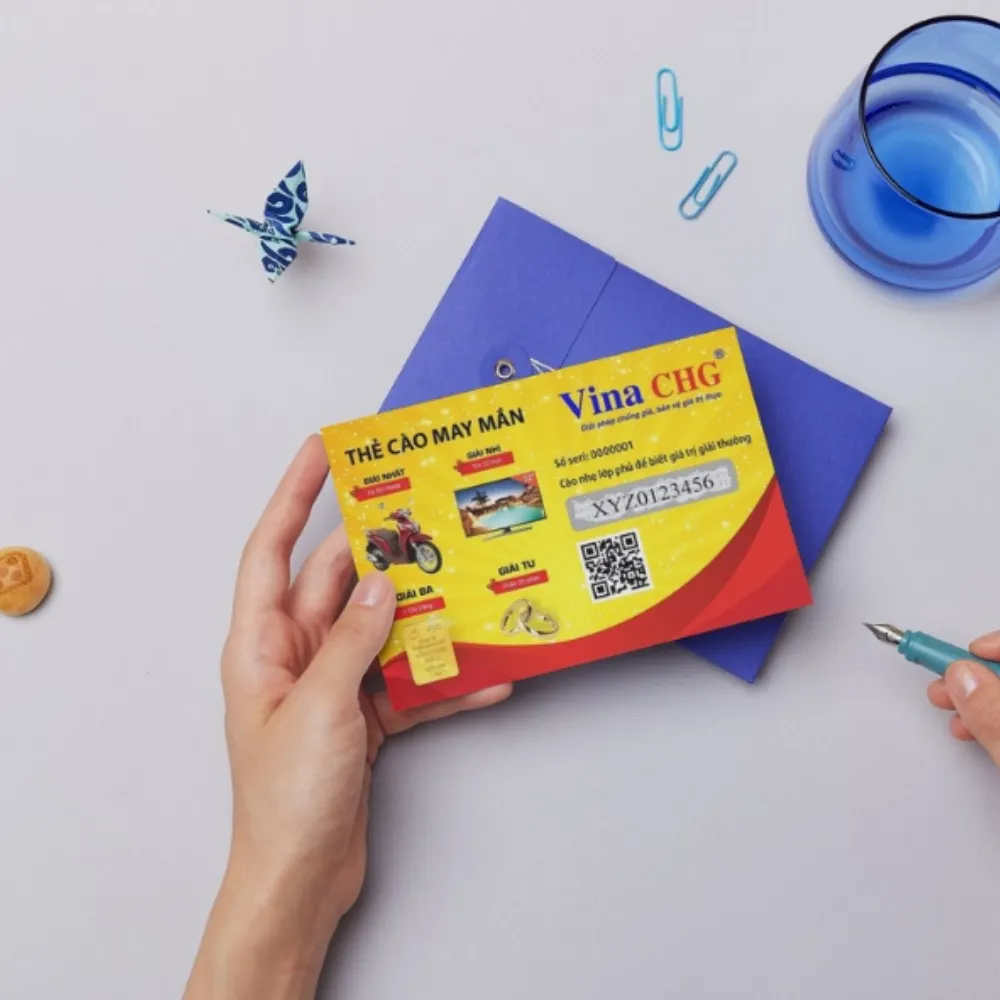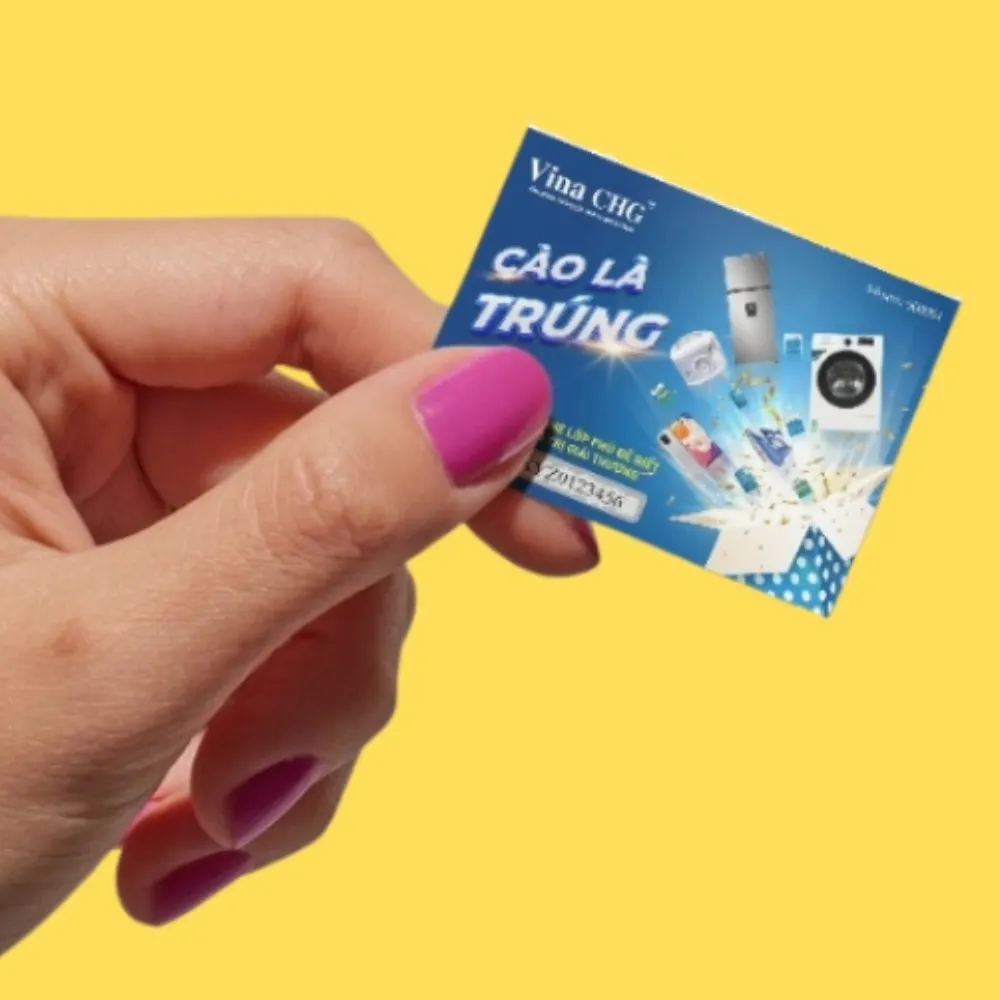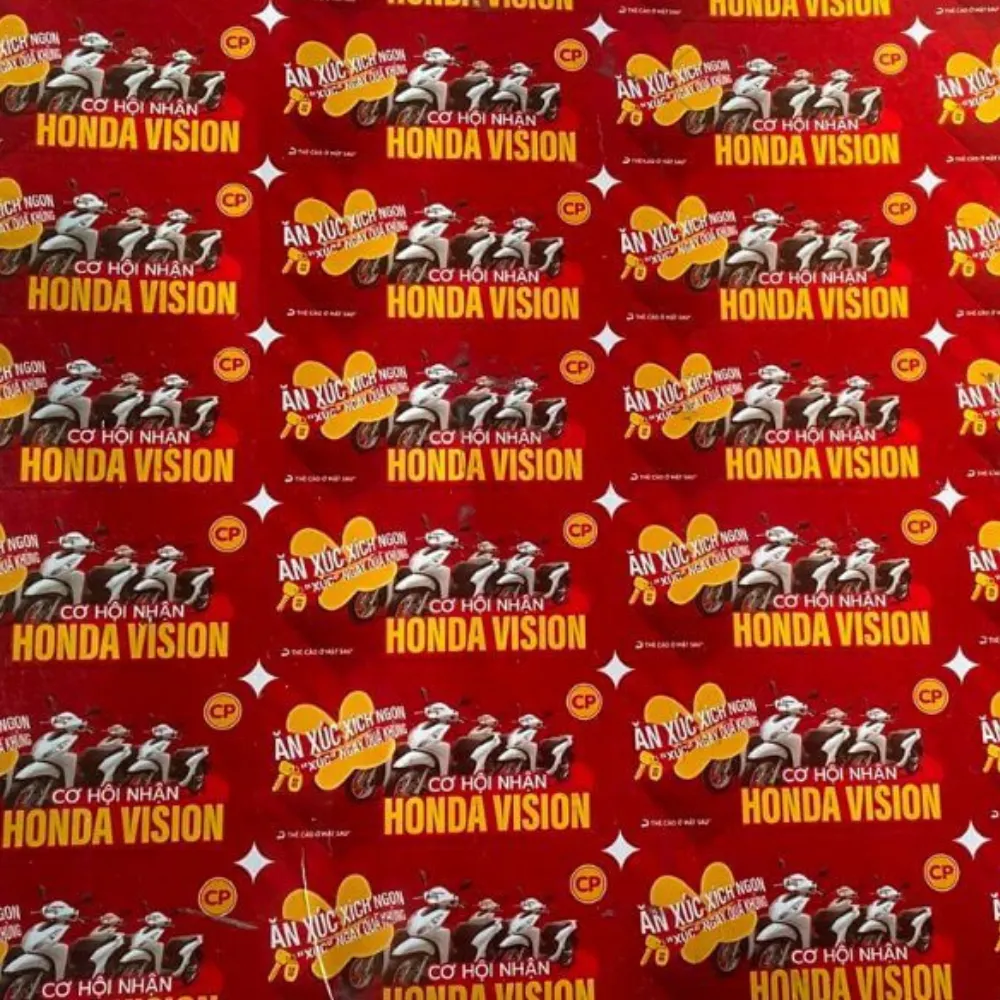Scratch Card Printing
Share
Brand
Vina CHG
Size
9 x 5 cm, 6 x 4 cm
ODM/OEM
Ability to change product details
Minimum Order Quantity (MOQ)
6,000 service package
Provide samples
Yes
Product Condition
100% New
Main Export Market
Vietnam
Packaging
Packaging type
service package
Packaging Detail
Packaged in cartons according to order quantity
B2B Sales Policy
Negotiable
Negotiable
Negotiable
Detailed description
Today's market offers various types of scratch cards (scratch coupons), each serving a specific marketing purpose. Most commonly, there are 3 main types of scratch cards:
Prize Scratch Cards are the most popular promotional tool, operating in the form of scratching for prizes. Printing prize scratch cards helps attract consumers, stimulate purchases, and create a revenue boom during special occasions such as grand openings, new product launches, or year-end holidays.
Points Accumulation Scratch Cards combine anti-counterfeiting features with reward points accumulation through call center messaging technology or QR Code scanning. This is a perfect solution for loyalty programs, simultaneously protecting the brand and increasing customer engagement.
Anti-Counterfeit Scratch Cards integrate high-security technologies along with traceability software. This type of card not only supports promotional campaigns but also prevents fraud and counterfeiting of scratch cards, protecting brand reputation and ensuring legitimate consumer rights.
With scratch-off coating technology that prevents counterfeiting and re-coating after scratching, anti-counterfeit scratch cards provide absolute peace of mind for businesses when implementing programs with high prize values (According to Vina CHG, the anti-counterfeiting technology complies with Decree 60/2014/ND-CP on anti-counterfeiting).
To produce high-quality scratch cards, many complex stages are required, with materials and processes playing a crucial role. Let's delve into the details of popular scratch card printing materials and specifications on the market:
Printing Materials:
Couche Paper (C250gsm and C300gsm): High-quality paper specially treated to prevent light penetration, completely blocking the reading of codes or content hidden under the scratch-off layer. This material also prevents surface peeling and resists fraudulent methods like using a laser light to scan horizontally.
Ivory Paper and Bristol Paper: Harder than Couche paper, offering a luxurious feel.
Art Paper: Features textures with diverse colors, creating uniqueness and creativity.
Decal or PVC Plastic: This material is commonly used for game point cards or membership cards due to its good water resistance.
Printing Methods:
Offset Printing is the most common method for large-volume scratch card production. This technology provides sharp print quality, accurate colors, and reasonable costs for bulk printing of 1000 cards or more. Offset is suitable for large-scale promotional scratch card campaigns, ensuring consistent quality across the entire print run.
Digital Printing offers flexibility for small orders or urgent deliveries. This method allows for individual customization of each card with unique information, suitable for VIP programs or market testing. Production time is fast, ranging from 2-3 business days.
3D Digital Laser Engraving creates a high-level security effect with unique 3D images. This technology produces micro-details that cannot be duplicated by conventional printing methods, ensuring uniqueness and effective anti-counterfeiting for high-value scratch cards.
Scratch-off Layers:
Standard Scratch-off Layer (Scratch foil): This is the common scratch foil layer often found on low-cost scratch cards with few outstanding technologies.
Anti-Scan Scratch-off Layer: This is a scratch-off layer designed for easy scratching, anti-scanning, and preventing re-coating after scratching, thereby stopping counterfeiting or re-use of cards.
Hologram Scratch-off Layer: This is a scratch-off layer with 7 colors that enhances aesthetics, but its disadvantage is that this type typically has very high costs.
Additional Technologies Integrated into Scratch Cards:
QR Code: Modern scratch cards not only feature traditional scratch-off layers but also integrate technologies like QR Codes, allowing customers to scan and authenticate genuine products, check prizes, or accumulate points online. This system operates by connecting to the enterprise's management software, enabling real-time updates.
SMS: The SMS switchboard allows customers to text to check prize results or accumulate points. This method is particularly suitable for customers who do not use smartphones or are in rural areas. The system automatically responds quickly, ensuring a smooth user experience.
Integrated Promotion Management Software helps businesses track the entire campaign, from the number of cards issued, participation rates, to prize distribution. Collected data is analyzed to provide important insights for subsequent marketing strategies.
Security Patterns: A scratch card can also feature additional patterns to enhance security. In case of issues, these patterns can help authorities determine if a scratch card is genuine or fake. Additionally, consumers can use these signs to accurately identify whether their scratch card is authentic or counterfeit.
Post-printing Stages:
Lamination (Glossy or Matte): This stage makes the card more durable, specifically making it water-resistant and scratch-resistant.
Rounded Corners, Die-cutting according to design: Adds aesthetics, professionalism, or a unique touch to the scratch card.
Each scratch card will have a different price based on the needs of each business.





